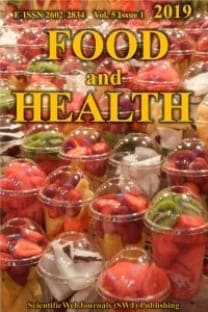EVALUATION OF ANTIOXIDANT AND CHOLINESTERASE INHIBITORY ACTIVITIES OF SOME MEDICINAL PLANTS
___
Baytop, T. (1984). Türkiye’de Bitkilerle Tedavi (Geçmişte ve Bugün). İstanbul: İstanbul University Press, p. 184, 221-2, 226, 258-9, 417, ISBN 9789754200218Benso, B., Franchin, M., Massarioli, A.P., Paschoal, J.A.R., Alencar, S.M., Franco, G.C.N., Rosalen, P.L. (2016). Anti-inflammatory, anti-osteoclastogenic and antioxidant effects of Malva sylvestris extract and fractions: in vitro and in vivo studies. PLoS One 11(9), e0162728.
Blois, M.S. (1958). Antioxidant determinations by the use of a stable free radical. Nature, 181, 1199-1200.
Boğa, M., Hacıbekiroğlu, I., Kolak, U. (2011). Antioxidant and anticholinesterase activities of eleven edible plants. Pharmaceutical Biology, 49, 290-295.
Boğa, M., Ertaş, A., Yılmaz, M.B., Kızıl, M., Çeken, B., Haşimi, N., Yılmaz Özden, T., Demirci, S., Yener, İ., Deveci, Ö. (2016). UHPLC-ESI-MS/MS and GC-MS analyses on phenolic, fatty acid and essential oil of Verbascum pinetorum with antioxidant, anticholinesterase, antimicrobial and DNA damage protection effects. Iranian Journal of Pharmaceutical Research, 15, 393- 405.
Craft, B.D., Kerrihard, A.L., Amarowicz, R., Pegg, R.B. (2012). Phenol-based antioxidants and the in vitro methods used for their assessment. Comprehensive Reviews in Food Science and Food Safety, 11, 148-173.
Dudonné, S., Vitrac, X., Coutière, P., Woilllez, M., Mérillon, J-M. (2009). Comparative study of antioxidant properties and total phenolic content of 30 plant extracts of industrial interest using DPPH, ABTS, FRAP, SOD, and ORAC assays. Food Chemistry, 57, 1768- 1774.
Ellman, G.L., Courtney, K.D., Andres, V., Featherston, R.M. (1961). A new and rapid colorimetric determination of acetylcholinesterase activity. Biochemical Pharmacology, 7, 88-95.
Ertaş, A., Boğa, M., Haşimi, N., Yeşil, Y., Gören, A.C., Topçu, G., Kolak, U. (2014). Antioxidant, anticholinesterase, and antimicrobial activities and fatty acid constituents of Achillea cappadocica Hausskn. et Bornm. Turkish Journal of Chemistry, 38, 592-599.
Ferreira, A., Proenca, C., Serralheiro, M.L.M., Araujo, M.E.M. (2006). The in vitro screening for acetylcholinesterase inhibition and antioxidant activity of medicinal plants from Portugal. Journal of Ethnopharmacology, 108, 7-31.
Gholamhoseinian, A., Moradi, M.N., Sharifi-Far, F. (2009). Screening the methanol extracts of some Iranian plants for acetylcholinesterase inhibitory activity. Research in Pharmaceutical Sciences, 4, 105-112.
Gülçin, İ., Küfrevioğlu, Ö.İ., Oktay, M., Büyükokuroğlu, M.E. (2004). Antioxidant, antimicrobial, antiulcer and analgesic activities of nettle (Urtica dioica L.). Journal of Ethnopharmacology, 90, 205-215.
Hamad, İ., Erol-Dayi, Ö., Pekmez, M., Önay-Uçar, E., Arda, N. (2010). Antioxidant and cytotoxic activities of Aphanes arvensis extracts. Plant Foods for Human Nutrition, 65, 45-49.
Hartman, R.E. (2009). Phytochemicals in cell function and Alzheimer’s disease pathology. In L. Packer, H. Sies, M. Eggersdorfer & E. Cadenas (Eds.) Micronutrients and Brain Health (p. 225-241). New York, NY: CRC press. ISBN 9781420073515
Howes, M-J.R., Perry, N.S.L., Houghton, P.F. (2003). Plants with traditional uses and activities, relevant to the management of Alzheimer’s disease and other cognitive disorders. Phytotherapy Research, 17, 1-18.
Keskin, C., Aktepe, N., Yükselten, Y., Sunguroğlu, A., Boğa, M. (2017). In-vitro antioxidant, cytotoxic, cholinesterase ınhibitory activities and anti-genotoxic effects of Hypericum retusum Aucher flowers, fruits and seeds methanol extracts in human mononuclear leukocytes. Iranian Journal of Pharmaceutical Research, 16, 210-220.
Liang, N., Kitts, D.D. (2014). Antioxidant property of coffee components: Assessment of methods that define mechanisms of action. Molecules, 19, 19180-19208.
Nasri, H., Baradaran, A., Shirzad, H., Rafieian-Kopaei, M. (2014). New concepts in nutraceuticals as alternative for pharmaceuticals. International Journal of Preventive Medicine, 5, 1487-1499.
Nishikimi, M., Rao, N.A., Yagi, K. (1972). The occurrence of superoxide anion in the reaction of reduced phenazine methosulfate and moleculer oxygen. Biochemical and Biophysical Research Communications, 46, 849- 854.
Oh, J., Jo, H., Cho, A.R., Kim, S-J., Han, J. (2012). Antioxidant and antimicrobial activities of various leafy herbal teas. Food Control, 31, 403-409.
Orhan, İ., Aslan, S., Kartal, M., Şener, B., Başer, K.H.C. (2008). Inhibitory effect of Turkish Rosmarinus officinalis L. on acetylcholinesterase and butyrylcholinesterase enzymes. Food Chemistry, 108, 663-668.
Park, Y.K., Koo, M.H., Ikegaki, M., Contado, J.L. (1997). Comparison of the flavonoid aglycone contents of Apis mellifera propolis from various regions of Brazil. Brazilian Archives of Biology and Technology, 40, 97-106.
Piazzi, L., Cavalli, A., Colizzi, F., Belluti, F., Bartolini, M., Mancini, F., Recanatini, M., Andrisano, V., Rampa, A. (2008). Multi-target-directed coumarin derivatives: hAChE and BACE1 inhibitors as potential anti-Alzheimer compounds. Bioorganic & Medicinal Chemistry Letters, 18, 423-426.
Re, R., Pellegrini, N., Proteggente, A., Pannala, A., Yang, M., Rice-Evans, C. (1999). Antioxidant activity applying an improved ABTS radical cation decolorization assay. Free Radical Biology & Medicine, 26, 1231- 1237.
Reische, D.W., Lillard, D.A., Eitenmiller, R.R. (2002). Antioxidants. In C.C. Akoh & D.B. Min (Eds.), Food Lipids: Chemistry, Nutrition, and Biotechnology (p. 489- 516). New York, NY: Marcel Dekker Inc. ISBN 0-8247-0749-4
Samuelsson, G., Bohlin L. (1999). Drugs of natural origin: a text book of pharmacognosy. Stockholm: Swedish P’ceutical Press, ISBN 9789186274818
Slinkard, K., Singleton, V.L. (1977). Total phenol analysis automation and comparison with manual methods. American Journal of Enology and Viticulture, 28, 49- 55.
Wong, S.P., Leong, L.P., Koh, J.H.W. (2006). Antioxidant activities of aqueous extracts of selected plants. Food Chemistry, 99, 775-783.
- ISSN: 2602-2834
- Yayın Aralığı: Yılda 4 Sayı
- Başlangıç: 2018
- Yayıncı: ScientificWebJournals (SWJ) Özkan Özden
BIOGENIC AMINE CONTENTS OF FRESH AND MATURE KASHAR CHEESES DURING REFRIGERATED STORAGE
Songül ŞAHİN ERCAN, ÇİĞDEM SOYSAL, HÜSEYİN BOZKURT
ANTIBACTERIAL AND ANTIOXIDANT ACTIVITY OF MYCELIAL EXTRACTS OF DIFFERENT PLEUROTUS SPECIES
MURAT ÖZDAL, Özlem GÜLMEZ, Özlem GÜR ÖZDAL, Ömer ALGUR
Faith Osasu-Oviaesu OMOROTIONMWAN, Happiness Isioma OGWU, Matthew Chidozie OGWU
EVALUATION OF ANTIOXIDANT AND CHOLINESTERASE INHIBITORY ACTIVITIES OF SOME MEDICINAL PLANTS
Ezgican ULAÇ, Pelin KÖSEOĞLU YILMAZ, Ufuk KOLAK
YULAF EKMEĞİ ÜRETİM AŞAMALARININ FENOLİK MADDE İÇERİĞİ VE ANTİOKSİDAN AKTİVİTEYE ETKİSİ
Berna TOPÇU, Zeynep TACER CABA, Dilara NİLÜFER ERDİL
Sümeyra GÜRKÖK, Zümrüt B. ÖGEL
LİNOLEİK ASİDİN SAFLAŞTIRILMASINDA DÜŞÜK SICAKLIK KRİSTALİZASYON YÖNTEMİNİN ETKİNLİĞİ
